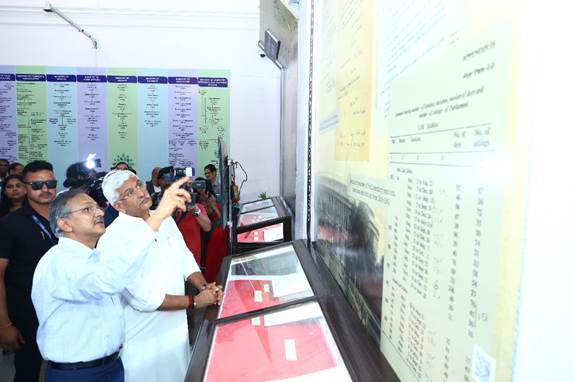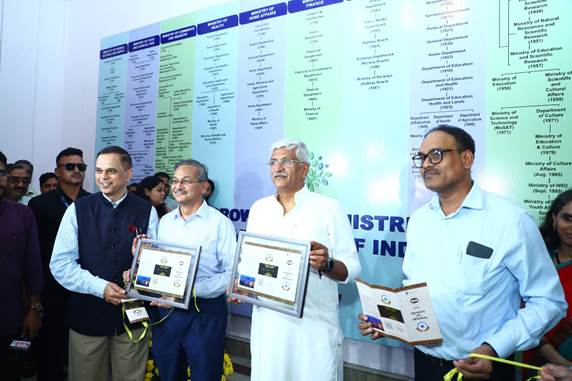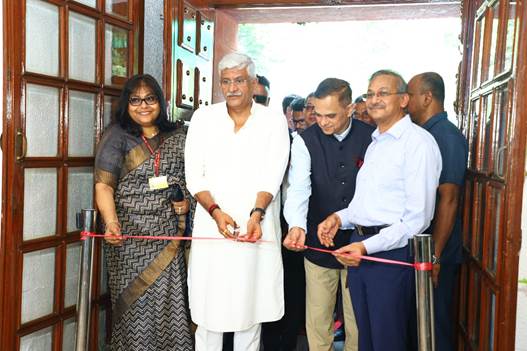Records Make Us Aware of the Reality and Direction of the Governance: Union Minister Shri Gajendra Singh Shekhawat
Union Minister of Culture and Tourism, Shri Gajendra Singh Shekhawat, today inaugurated the exhibition titled “Sushasan aur Abhilekh” (Good Governance and Records) at the National Archives of India, Janpath, New Delhi. He also observed the records displayed here and also reviewed the system of conservation of records in a meeting. On this occasion Shri Shekhawat said, records make us aware of the reality of the condition and direction of the governance. The exhibition showcased newly acquired historical documents from various ministries and departments of the Government of India.
Over the past decade, the Government of India’s cleanliness campaign not only improved public health but also encouraged the preservation of the nation’s historical archives. A significant aspect of this campaign involved the review, disposal, and evaluation of old records across various ministries, departments, and other government entities, aiming to transfer historically significant records to the National Archives of India (NAI). This initiative played a vital role in ensuring that the foundation of good governance—well-preserved archival records—was reinforced for future generations.
Under the Swachh Bharat Mission from 2021 to 2024, approximately 74,000 files of historical importance were transferred to the National Archives after appraisal from 11 ministries and departments. Through this exhibition, the National Archives provided a glimpse of these newly acquired documents, offering insights into the evolution of governance in India.

The exhibition emphasized the collaboration between the National Archives of India and various ministries and departments in preserving records of lasting historical significance, highlighting the principles of cleanliness and governance that drive progress across all sectors of society.

Visitors were offered a rare glimpse into invaluable historical documents acquired during Special Campaigns. From the operations of the President’s Secretariat to advancements in water resources management, several key highlights were featured:
President’s Secretariat: The exhibition displayed documents, including the first aerial photography of Rashtrapati Bhawan and the elevation of General Sam Manekshaw as India’s first Field Marshal.
Election Commission of India: Visitors were able to trace the journey from ballot boxes to the implementation of Electronic Voting Machines (EVMs), first introduced in the 1982 Kerala Assembly elections.
Ministry of Railways: Records showcased Indian Railways’ role in expanding rail networks both within India and internationally, in countries like Sri Lanka and Myanmar.
Ministry of Water Resources: Documents related to India’s long-standing history of water conservation, including materials on the Som Kamla Amba Project and the National Water Policy, were on display.
Ministry of Law and Justice: Archival materials highlighted the post-independence renaming of the Imperial Library to the National Library, along with discussions on the 1955 Citizenship Bill.
Ministry of Power: Key records related to major power projects, such as the Tehri Dam and Koteshwar Dam in Uttarakhand, were featured.
Ministry of Parliamentary Affairs: The exhibition included displays on significant legislative developments, such as Constitutional Amendment Bills and the election of the Speaker of Lok Sabha and Deputy Chairman of Rajya Sabha.
Ministry of Commerce and Industry: Visitors explored important records related to India’s trade and industrial growth, including documents on the Bofors Committee and the National Renewal Fund (NRF).
Ministry of Heavy Industries and Public Enterprises: Engineering marvels, such as the Hooghly Bridge in Kolkata, were highlighted through original documents.
Patent Office: Notable patents, such as the multilingual typewriter patented by Viswas Raghunath Bharve, were showcased.
Press Information Bureau: The exhibition also featured significant events, such as the awarding of the Padma Vibhushan to General Jayanto Nath Chaudhuri and Air Marshal Arjan Singh, as well as Sardar Vallabhbhai Patel’s 1950 address on Calcutta Radio.
“Sushasan aur Abhilekh” exemplified the importance of maintaining a clean administrative and governmental environment alongside a robust archival system that preserves invaluable historical records for future generations. Through this collection, NAI not only celebrated the Swachh Bharat Mission but also showcased how proper management of records ensures transparency, accountability, and preservation of the nation’s rich history. The exhibition was open to the public from 1st October 2024, 10.00 am to 4.00 pm, at the National Archives of India, New Delhi.
The National Archives of India is an Attached Office under The Ministry of Culture. It was established on 11 March 1891 at Kolkata (Calcutta) as the Imperial Record Department. Following the transfer of the capital from Calcutta to Delhi in 1911, the present building of the National Archives of India was constructed in 1926 which was designed by Sir Edwin Lutyens. The transfer of all records from Calcutta to New Delhi was completed in 1937. It is the nodal agency for the implementation of the Public Records Act, 1993 and Public Records Rules, 1997.

